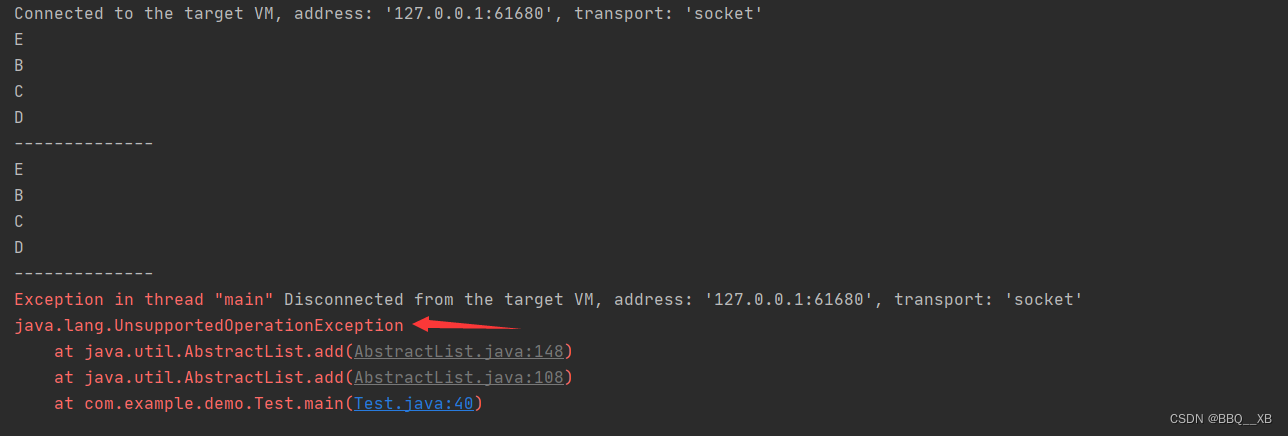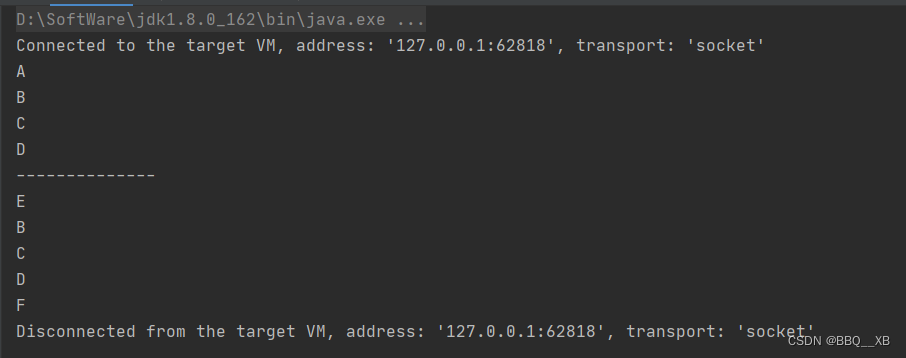-
Arrays.asList() 和 new ArrayList() 的区别(详解)
Arrays.asList()
源码及分析
package java.util; public class Arrays { /** * Returns a fixed-size list backed by the specified array. (Changes to * the returned list "write through" to the array.) This method acts * as bridge between array-based and collection-based APIs, in * combination with {@link Collection#toArray}. The returned list is * serializable and implements {@link RandomAccess}. * *This method also provides a convenient way to create a fixed-size * list initialized to contain several elements: *
* List<String> stooges = Arrays.asList("Larry", "Moe", "Curly"); ** * @paramthe class of the objects in the array * @param a the array by which the list will be backed * @return a list view of the specified array */ @SafeVarargs @SuppressWarnings("varargs") public static <T> List<T> asList(T... a) { return new ArrayList<>(a); } /** * @serial include */ private static class ArrayList<E> extends AbstractList<E> implements RandomAccess, java.io.Serializable { private static final long serialVersionUID = -2764017481108945198L; private final E[] a; ArrayList(E[] array) { a = Objects.requireNonNull(array); } @Override public int size() { return a.length; } @Override public Object[] toArray() { return a.clone(); } ....... } }- 1
- 2
- 3
- 4
- 5
- 6
- 7
- 8
- 9
- 10
- 11
- 12
- 13
- 14
- 15
- 16
- 17
- 18
- 19
- 20
- 21
- 22
- 23
- 24
- 25
- 26
- 27
- 28
- 29
- 30
- 31
- 32
- 33
- 34
- 35
- 36
- 37
- 38
- 39
- 40
- 41
- 42
- 43
- 44
- 45
- 46
- 47
- 48
- 49
- 50
- Arrays是一个java.util包中的一个类。通过调用asList()这个方法,获取到一个集合,asList()方法中的实现就是new ArrayList();。但是值得注意的是new的这个ArrayList不是java.util包中的ArrayList,而是Arrays中的这个内部类ArrayList。
- 内部类java.util.Arrays.ArrayList虽然也是继承了AbstractList这个抽象类,但是它并没有和java.util.ArrayList一样,去实现add()等方法,那这样的话,如果调用add()方法,其实就是调用父类AbstractList类当中的add()方法,但是AbstractList.add()就抛出了异常。
- 另外,Arrays.asList()拿到的集合是原本数组的引用,在初始化的java.util.Arrays.ArrayList的时候,将原本的数据存放到一个private并且final的数组中。
AbstractList源码:
/** * {@inheritDoc} * *This implementation always throws an * {@code UnsupportedOperationException}. * * @throws UnsupportedOperationException {@inheritDoc} * @throws ClassCastException {@inheritDoc} * @throws NullPointerException {@inheritDoc} * @throws IllegalArgumentException {@inheritDoc} * @throws IndexOutOfBoundsException {@inheritDoc} */
public E set(int index, E element) { throw new UnsupportedOperationException(); } /** * {@inheritDoc} * *This implementation always throws an * {@code UnsupportedOperationException}. * * @throws UnsupportedOperationException {@inheritDoc} * @throws ClassCastException {@inheritDoc} * @throws NullPointerException {@inheritDoc} * @throws IllegalArgumentException {@inheritDoc} * @throws IndexOutOfBoundsException {@inheritDoc} */
public void add(int index, E element) { throw new UnsupportedOperationException(); } /** * {@inheritDoc} * *This implementation always throws an * {@code UnsupportedOperationException}. * * @throws UnsupportedOperationException {@inheritDoc} * @throws IndexOutOfBoundsException {@inheritDoc} */
public E remove(int index) { throw new UnsupportedOperationException(); }- 1
- 2
- 3
- 4
- 5
- 6
- 7
- 8
- 9
- 10
- 11
- 12
- 13
- 14
- 15
- 16
- 17
- 18
- 19
- 20
- 21
- 22
- 23
- 24
- 25
- 26
- 27
- 28
- 29
- 30
- 31
- 32
- 33
- 34
- 35
- 36
- 37
- 38
- 39
- 40
- 41
- 42
- 43
- 44
测试
public class Test { public static void main(String[] args) { String[] stringArray = new String[]{"A", "B", "C", "D"}; List<String> stringList = Arrays.asList(stringArray); stringList.set(0,"E"); Arrays.stream(stringArray).forEach((e)-> System.out.println(e)); System.out.println("--------------"); stringList.stream().forEach((e)-> System.out.println(e)); System.out.println("--------------"); stringList.add("F"); } }- 1
- 2
- 3
- 4
- 5
- 6
- 7
- 8
- 9
- 10
- 11
- 12
- 13
- 14
- 15
结果:

结论:- Arrays.asList 返回的 ArrayList 是一个固定长度(fixed-size)List 对象,只对 Array 进行了包装,返回的是Array的引用(a = Objects.requireNonNull(array);),如list对元素修改,则也会改变Array 的值。
- 没有实现 add 和 remove等 方法(不支持该操作,若操作后抛异常 java.lang.UnsupportedOperationException)。
new ArrayList()
List<String> list = new ArrayList();- 1
源码及分析
public class ArrayList<E> extends AbstractList<E> implements List<E>, RandomAccess, Cloneable, java.io.Serializable { /** * Constructs an empty list with the specified initial capacity. * * @param initialCapacity the initial capacity of the list * @throws IllegalArgumentException if the specified initial capacity * is negative */ public ArrayList(int initialCapacity) { if (initialCapacity > 0) { this.elementData = new Object[initialCapacity]; } else if (initialCapacity == 0) { this.elementData = EMPTY_ELEMENTDATA; } else { throw new IllegalArgumentException("Illegal Capacity: "+ initialCapacity); } } /** * Constructs an empty list with an initial capacity of ten. */ public ArrayList() { this.elementData = DEFAULTCAPACITY_EMPTY_ELEMENTDATA; } /** * Constructs a list containing the elements of the specified * collection, in the order they are returned by the collection's * iterator. * * @param c the collection whose elements are to be placed into this list * @throws NullPointerException if the specified collection is null */ public ArrayList(Collection<? extends E> c) { elementData = c.toArray(); if ((size = elementData.length) != 0) { // c.toArray might (incorrectly) not return Object[] (see 6260652) if (elementData.getClass() != Object[].class) elementData = Arrays.copyOf(elementData, size, Object[].class); } else { // replace with empty array. this.elementData = EMPTY_ELEMENTDATA; } } }- 1
- 2
- 3
- 4
- 5
- 6
- 7
- 8
- 9
- 10
- 11
- 12
- 13
- 14
- 15
- 16
- 17
- 18
- 19
- 20
- 21
- 22
- 23
- 24
- 25
- 26
- 27
- 28
- 29
- 30
- 31
- 32
- 33
- 34
- 35
- 36
- 37
- 38
- 39
- 40
- 41
- 42
- 43
- 44
- 45
- 46
- 47
- 48
- ArrayList是java.util包中的类,如上述代码所示,ArrayList是继承了AbstractList这个抽象类,并且实现了List接口。
- List接口的话,是集合的一个比较重要的接口。这里有一下集合的基本操作方法,比如说add,remove等一系列的操作。AbstractList这个抽象类,虽然实现了List接口,也实现了add,remove等方法,但都只是抛出UnsupportedOperationException()。具体的实现还是看ArrayList类。
测试
public class Test { public static void main(String[] args) { String[] stringArray2 = new String[]{"A", "B", "C", "D"}; List<String> stringList2 = new ArrayList<>(Arrays.asList(stringArray2)); stringList2.set(0, "E"); Arrays.stream(stringArray2).forEach((e) -> System.out.println(e)); System.out.println("--------------"); stringList2.add("F"); stringList2.stream().forEach((e) -> System.out.println(e)); } }- 1
- 2
- 3
- 4
- 5
- 6
- 7
- 8
- 9
- 10
- 11
- 12
- 13
- 14
- 15
结果:

结论:
- new ArrayList() 返回的对象,通过源码elementData = Arrays.copyOf(elementData, size, Object[].class);可以看出,list是 Array 中数据拷贝过来的,这个新的 List 与老的 Array 没有关系,对新 List 中数据的操作不会影响到老的 Array 中的数据。
- ArrayList类实现 add 和 remove等 方法,可动态调整list长度。
主要不同的地方就是在于是否能够对转换后的数组进行元素的添加和删除等常规操作。
-
相关阅读:
12. 自动化项目实战
开发成本类似快递出入库寄收件成本多少
OpenCV 视频处理(关于摄像头和视频文件的读取、显示、保存等等)
同步云盘:理解云端数据的实时同步技术
hiberate核心API/配置文件/一级缓存详解
MySQL进阶-覆盖索引
关于Nginx跨域配置的一些问题,详解如何正确的配置跨域
Facebook会话过期是什么情况?如何解决?
Python操作lxml库(基础篇)
HTML-基础 测试题部分103
- 原文地址:https://blog.csdn.net/BBQ__ZXB/article/details/126765763
